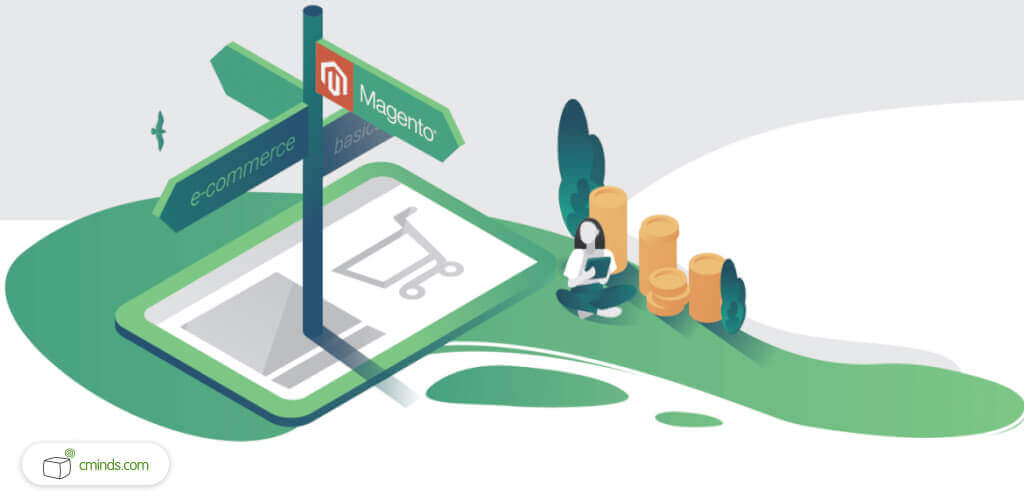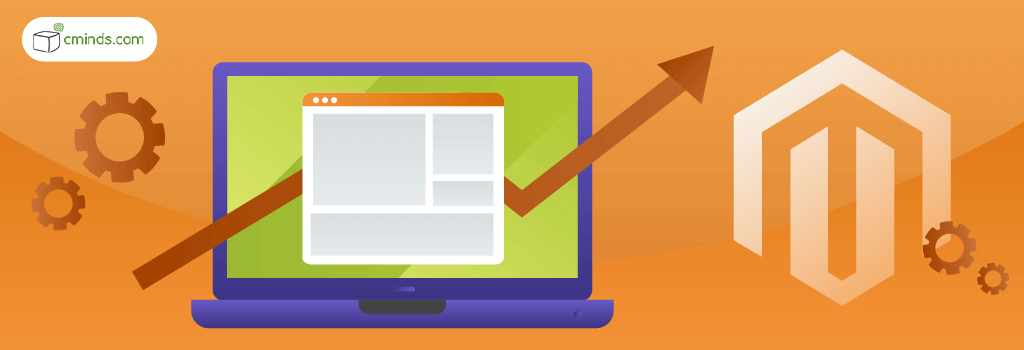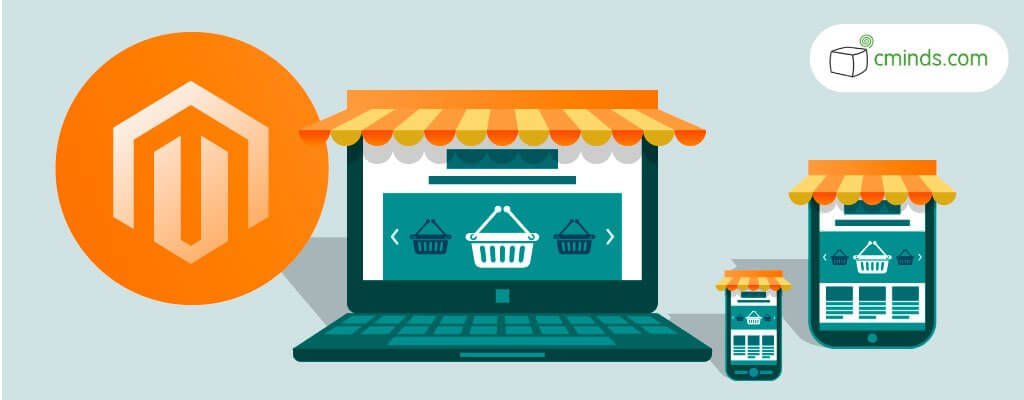eCommerce has been growing rapidly for a decade. This ultimate eCommerce guide will cover this history and more.

These days business owners everywhere know eCommerce works as an effective tool for building a profitable store. Use this handy ultimate eCommerce guide can help getting it started.
Ultimate eCommerce Guide: What is eCommerce?

eCommerce, or electronic commerce, is commercial transactions transferred electronically on the Internet. To put it briefly, eCommerce means buying and selling goods or services via the internet on any device.
There are many types of eCommerce activities like online ticketing or auctions, internet banking which is used worldwide. The most known examples of global online stores are Amazon.com, eBay or Alibaba.
In this ultimate eCommerce guide, you will learn the differences between electronic and regular commerce, eCommerce basic concepts, and will get to know Magento as a great example of the eCommerce platform.
April 2025 Offer – For a Limited Time Only:
Get All Access Pass Package for Magento 2 for 25% off! Don’t miss out!
Ultimate eCommerce Guide: eCommerce vs Traditional Commerce
As we learned before, eCommerce is an online commercial transaction between a supplier and a client that helps both reach a global market, without investing tons of money. In comparison with eCommerce, traditional commerce is the exchange of products in person. It means you need to interact with sales representatives or owners one by one to get services or goods. Let’s compare eCommerce and traditional commerce based on the following ideas:
1. Costs

While owners of physical stores face the costs of maintaining stores and warehousing, eCommerce benefits from managing a store online where only an Internet connection and technical development are required. Online stores are mostly focused on product storage and development and can offer flexible solutions to customers like discounts. But on the other side, they totally depend on cost related to software development, advertising cost, highly paid software developers, connection and setup cost.
2. Global Market
Running a physical store may be limited within a specific geographical area. However, eCommerce doesn’t really relate to where an online store is registered. That is why online stores have more possibilities to reach consumers in distant locations easily and cheaply. Customers can easily browse a global market with no additional charges and purchase products from multiple parts of the world at once.
3. Availability
Physical stores are usually open during 8-10 hours a day and depend on having an employee on-site. Online stores are always open, no matter when customers purchase products. Unrestricted by the working hours, online stores can serve customers 24x7x365.
4. Delivery
Traditional commerce delivers products immediately to customers in physical stores. In the case of eCommerce, all the goods are delivered at the customer’s location, but it takes some time to process customs procedures if the products are ordered from a different part of the world.
5. Marketing

In this case, eCommerce is more agile of attracting more users online and finding potential customers within a short period of time. Online stores can address hundreds or thousands of customers at once and offer products based on data. Traditional commerce addresses a certain group of potential customer and uses other marketing tools as printed material, presentations, which may cost more than your budget allows.
Ultimate eCommerce Guide: How big is the global e-commerce market today?
Here is an essential section of the ultimate eCommerce guide: statistics!
What are the reasons that eCommerce has shown such an explosive growth pushing a traditional method away? By 2021 retail eCommerce is aimed to hit $4.800 trillion worldwide, which is driven by creating fast-developed online companies and advanced mobile devices supposed to be extremely convenient for online shopping.

Retail e-commerce sales worldwide from 2014 to 2021 (in billion U.S. dollars) From www.statista.com
In 2021 the US will have 230.5 digital shoppers. It’s also estimated that women tend to shop online more often than men.
In comparison with that, 40% of American men aged 18 to 34 said they would “ideally buy everything online,” compared to only 33% of women the same age. Talking about age, millennials, ages 18-34, tend to spend approximately $2.000 online each year, making it the generation that does the most online shopping.
What Are Must-Have Ecommerce Website Features?
Speaking about eCommerce basics, we always need to remember about its functionality and features.
Online stores with poor functionality and features may rarely achieve true success if you rely on a product base only.
It’s important to stress in this ultimate eCommerce guide: implement tools to run your website effectively and manage business processes smoothly.
For example, by using the correct functionality you can easily manage hundreds of products at once, track multiple orders, add various payment methods to be sure your customers get excellent service.
With this ultimate eCommerce guide, we recommend the following features to have on your website to run a successful online business:
Marketing, Promotions and Conversion Tools

In comparison with traditional commerce, eCommerce marketing is more focused on tactics to drive more clients to a website, increase loyal customer base, and build brand awareness. Here is a list of features that will help you promote your products online:
- Create product bundles
- Multi-tier pricing for quantity discounts
- Related products, up-sells and cross-sells
- Discount pricing rules with the ability to restrict to stores, customer groups, time period, products, and categories
- Use discount coupon codes
- Newsletter management
- Free shipping options
- Persistent shopping cart
- Send wishlists by email
Search Engine Optimization (SEO)

Search Engine Optimization (SEO) helps you optimize your website with specific keywords to rank it higher in search results. It’s eCommerce basics. There are a lot of ways to optimize your website. Here are some which are must-have for any store.
- Google Site Map
- Search engine friendly URLs
- URL rewrites to give full control of URLs
- Meta-information for products, categories and content pages
- Auto-generated site map for display on site
- Auto-generated popular search terms page
Site Management

Site management plays a core role in successfully performing your website on the market. This is where all the management processes come from and set the main direction of the store’s development. This area includes the following features:
- Control multiple websites and stores from one Administration Panel
- Set permissions for managers
- Fully 100% customizable design using templates
- Support for multiple languages and currencies
- Multiple import and export of catalog and customer information
- Content Management System for landing pages
- Tax rates per location, product type or customer group (i.e. wholesale vs. retailer)
- Adding CAPTCHA functionality to protect the store from fake logins
Catalog Management

This is where the admin can manage all the details about categories and products from the Administrator Panel. This area is focused on creating and improving information about products and collecting items into manageable categories.
The following features will help you with building a comprehensive product base.
- Search and sort to easily find categories
- Manage categories and sub-categories
- Feature categories within navigation or on the homepage
- Set categories as “active” or “inactive”
- Set page URLs and SEO elements for categories
- Manage categories thumbnails and images
Checkout, Payment and Shipping

Once your customers add products to the cart, it’s necessary to provide them with an easy and secure checkout process. This is also an important part of running an online store as the type of payment or shipping methods can make a great impact on the customer’s purchase decision. You will find below the details which are important for a successful checkout:
- One-page checkout
- Guest checkout and checkout with account to use address book
- Shipping to multiple addresses in one order
- Saved shopping cart
- Shopping cart with tax and shipping estimates
- Saved credit card method for offline payments
- Shipping integration with label printing – view, edit, print labels for all major carriers
- Flat rate shipping per order or item
- Free shipping
- Table rates for weight, sub-total, destination and number of items
- On-site order tracking from customer accounts
Order Management

The Order Management section includes the ability to view, edit, create and fulfill orders from the Administrator Panel.
This is where the admins manage all the customer order details including products, addresses, send invoices and shipment information.
- Create one or multiple invoices, shipments and credit memos per order to allow for split fulfillment
- Print invoices, packing slips and shipping labels
- Tracking orders
- Enable sales representatives
- Create re-orders for customers
- Email notifications of orders
- RSS feed of new orders
Customer Accounts

It’s necessary to provide customers with their own accounts where they can track all the orders, add products to wishlists, enter credit cards and address information for future purchases. The following features are available:
- Address book with unlimited addresses
- Wish list with ability to add comments
- Order status and history
- Re-orders from account
- Recently ordered items
- Default billing and shipping addresses
- Email or send RSS feed of wishlist
- Newsletter subscription management
- Product reviews submitted
- Product tags submitted
- Downloadable/digital products
Customer Service

eCommerce customer service is a strategy for providing customer service to customers in online stores. It’s vital for a store owner to get customers feedback and for customers to track all the details, get important notifications, and more.
- Show Contact Us form
- Create and edit orders from the admin panel
- Feature-rich customer accounts
- Order history with status updates
- Order tracking from accounts
- Password reset email from front-end and admin panel
- Order and account update emails
- Customizable transaction emails
International Support

If you are running multiple stores which include different products for different countries, support various currencies and languages, it’s vital to remember about implementing the following features:
- Support for localization, multiple currencies and tax rates
- Support for accented characters and right-to-left text
- Integrated with Google Analytics
- Sales report
- Tax report
- Abandoned shopping cart report
- Best viewed products report
- Best purchased products report
- Low stock report
- Search terms report
- Product reviews report
- Tags report
- Coupon usage report
- Total sales invoiced
- Total sales refunded
- Quickly create a site optimized for any device using an included responsive design
Analytics and Reporting
To track your sales progression or reduction, integrate analytics to your online store as well as generate reports.
Mobile Commerce

As we mentioned above, millions of young people use mobile devices to purchase goods and services online. It means that optimizing pages for mobile versions will attract more mobile users from all over the world and bring you benefits in a short period of time.
eCommerce Platform Suggestion: Magento
After the ultimate eCommerce guide highlighted what functionality is necessary for building a successful online store, it’s time to define which eCommerce platform will be the best match for that.
What is Magento
Magento is a powerful eCommerce solution that will help your store succeed in the market. It is a popular eCommerce open-source platform built on the PHP programming language. Creating an online store from scratch can be done within the Magento Free or Premium versions.
Magento History
In 2007 officially the Beta version of Magento 1 was officially launched. After that Magento 1 was developed into Magento Community and Magento Enterprise. Both editions became widely known and used among developers. Its support has been officially discontinued – meaning no more security patches.
In July 2015, Magento 2 was launched. It was a great event in Magento history and for eCommerce. Nowadays, Magento 2 is getting more popular among online store owners. Just take a look at these figures – 46.16% of the world’s online stores located in the US are using Magento 2.
Third-party Plugins for Magento
Being an open-source platform Magento allows thousands of developers to extend online stores functionality by adding excellent and unique features.
You can find more examples of the most useful extensions for your Magento 1 and Magento 2 here.
Find more information about Magento, its features and extensions in this blog The Ultimate Beginners Guide to Magento
Conclusion
This ultimate eCommerce guide discussed the definition of eCommerce, compared it with traditional commerce, figured out the importance of eCommerce in our world, and described the platform based on the main principles of building a successful online store.
We live in an era of the greatest changes in technology which gives us a great chance to start your own business from scratch with minimum expenses.


